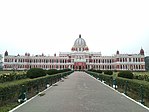District in West Bengal, India
Cooch Behar district (pronounced [ˈkuːtʃ biˈɦaːr]) is a district of the Indian state of West Bengal. Formerly part of the Kamarupa kingdom, the area became the heart of the Kamata Kingdom in the 12th century. During the British Raj, the district was known as Cooch Behar state ruled by the Koch dynasty until 1949, when it became part of India. The district consists of the flat plains of North Bengal and has several rivers: the most notable being the Teesta, Jaldhaka and Torsa. The district has the highest proportion of Scheduled Castes in the country, where they form a majority.
Etymology
Main article: Etymology of Cooch BeharThe name Cooch Behar is derived from two words—Cooch, a corrupted form of the word Koch, the name of the Koch tribes, and the word behar is derived from vihara meaning land, Koch Behar means land of the Koches.
History
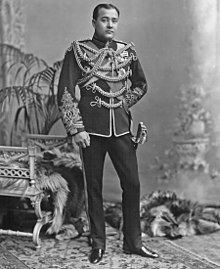
Early period
See also: Kamarupa Kingdom, Kamata kingdom, and Koch dynasty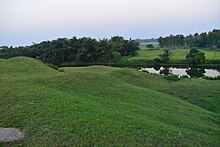
Cooch Behar formed part of the Kamarupa Kingdom of Assam from the 4th to the 12th centuries. In the 12th century, the area became a part of the Kamata Kingdom, first ruled by the Khen dynasty from their capital at Kamatapur. The Khens were an indigenous tribe, and they ruled till about 1498 CE, when they fell to Alauddin Hussain Shah, the independent Pathan Sultan of Gour. The new invaders fought with the local Bhuyan chieftains and the Ahom king Suhungmung and lost control of the region. During this time, the Koch tribe became very powerful and proclaimed itself Kamateshwar (Lord of Kamata) and established the Koch dynasty.
The first important Koch ruler was Biswa Singha, who came to power in 1515. Under his son, Nara Narayan, the Kamata Kingdom reached its zenith. Nara Narayan's younger brother, Shukladhwaj (Chilarai), was a noted military general who undertook expeditions to expand the kingdom. He became governor of its eastern portion.
After Chilarai's death, his son Raghudev became governor of this portion. Since Nara Narayan did not have a son, Raghudev was seen as the heir apparent. However, a late child of Nara Narayan removed Raghudev's claim to the throne. To placate him, Nara Narayan had to anoint Raghudev as a vassal chief of the portion of the kingdom east of the Sankosh river. This area came to be known as Koch Hajo. After the death of Nara Narayan in 1584, Raghudev declared independence. The kingdom ruled by the son of Nara Narayan, Lakshmi Narayan, came to be known as Cooch Behar. The division of the Kamata Kingdom into Koch Behar and Koch Hajo was permanent. Koch Behar aligned itself with the Mughal Empire and finally joined the India as a part of the West Bengal, whereas remnants of the Koch Hajo rulers aligned themselves with the Ahom kingdom and the region became a part of Assam.
As the early capital of the Koch Kingdom, Cooch Behar's location was not static and became stable only when shifted to Cooch Behar town. Maharaja Rup Narayan, on the advice of an unknown saint, transferred the capital from Attharokotha to Guriahati (now called Cooch Behar town) on the banks of the Torsa river between 1693 and 1714. The capital has always been in or near its present location since then.
In 1661 CE, Maharaja Pran Narayan planned to expand his kingdom. However, Mir Jumla, the subedar of Bengal under the Mughal emperor Aurangazeb, attacked Cooch Behar and conquered the territory, meeting almost no resistance. The town of Cooch Behar was subsequently named Alamgirnagar. Maharaja Pran Narayan regained his kingdom within a few days.
British Raj
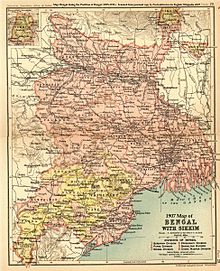
In 1772–1773, the king of Bhutan attacked and captured Cooch Behar. To expel the Bhutanese, the kingdom of Cooch Behar signed a defence treaty with the British East India Company on 5 April 1773. After expelling the Bhutanese, Cooch Behar became a princely kingdom under the protection of British East India company.
The Victor Jubilee Palace was based on Buckingham Palace and built in 1887, during the reign of Maharaja Nripendra Narayan. In 1878, the maharaja married the daughter of Brahmo preacher Keshab Chandra Sen. This union led to a renaissance in Cooch Behar state. Maharaja Nripendra Narayan is known as the architect of modern Cooch Behar town.
Post Independence
Under an agreement between the kings of Cooch Behar and the Indian Government at the end of British rule, Maharaja Jagaddipendra Narayan transferred full authority, jurisdiction and power of the state to the Dominion Government of India, effective 12 September 1949. Eventually, Cooch Bihar became part of the state of West Bengal on 19 January 1950, with Cooch Behar town as its headquarters.
Geography

Cooch Behar is a district under the Jalpaiguri Division of the state of West Bengal. Cooch Behar is located in the northeastern part of the state and bounded by the district of Jalpaiguri and Alipurduar in the north, Dhubri and Kokrajhar district of Assam in the east and by Bangladesh in the west as well as in the south. The district forms part of the Himalayan Terai of West Bengal.
A geopolitical curiosity was that there were 92 Bangladeshi exclaves, with a total area of 47.7 km in Cooch-Behar. Similarly, there were 106 Indian exclaves inside Bangladesh, with a total area of 69.5 km. These were part of the high stake card or chess games centuries ago between two regional kings, the Raja of Cooch Behar and the Maharaja of Rangpur.
Twenty-one of the Bangladeshi exclaves were within Indian exclaves, and three of the Indian exclaves were within Bangladeshi exclaves. The largest Indian exclave was Balapara Khagrabari which surrounded a Bangladeshi exclave, Upanchowki Bhajni, which itself surrounded an Indian exclave called Dahala Khagrabari, of less than one hectare (link to external map here ). But all this has ended in the historic India-Bangladesh land agreement. See Indo-Bangladesh enclaves.
Rivers and topography
Cooch Behar is a flat region with a slight southeastern slope along which the main rivers of the district flow. Most of the highland areas are in the Sitalkuchi region and most of the low-lying lands lie in Dinhata region.
The rivers in the district of Cooch Behar generally flow from northwest to southeast. Seven rivers that cut through the district are the Teesta, Jaldhaka, Torsha, Kaljani, Raidak, Gadadhar and Ghargharia.
Flora and fauna
In 1976 Cooch Behar district became home to the Jaldapara Wildlife Sanctuary (now Jaldapara National Park), which has an area of 217 km (83.8 sq mi). It shares the park with Alipurduar district.
Demographics
| Year | Pop. | ±% p.a. |
|---|---|---|
| 1901 | 565,116 | — |
| 1911 | 591,012 | +0.45% |
| 1921 | 590,599 | −0.01% |
| 1931 | 589,053 | −0.03% |
| 1941 | 638,703 | +0.81% |
| 1951 | 668,949 | +0.46% |
| 1961 | 1,019,806 | +4.31% |
| 1971 | 1,414,183 | +3.32% |
| 1981 | 1,771,643 | +2.28% |
| 1991 | 2,171,145 | +2.05% |
| 2001 | 2,479,155 | +1.34% |
| 2011 | 2,819,086 | +1.29% |
| source: | ||
According to the 2011 census Cooch Behar district has a population of 2,819,086, roughly equal to the nation of Jamaica. This gives it a ranking of 136th in India (out of a total of 739). The district has a population density of 833 inhabitants per square kilometre (2,160/sq mi). Its population growth rate over the decade 2001–2011 was 13.86%. Koch Bihar has a sex ratio of 942 females for every 1000 males, and a literacy rate of 75.49%. 10.27% of the population lives in urban areas. Scheduled Castes and Scheduled Tribes make up 1,414,336 (50.17%) and 18,125 (0.64%) of the population respectively. Cooch Behar is the only district in India where Scheduled Castes make up a majority of the population.
Religion
| Religions in Cooch Behar district (2011) | ||||
|---|---|---|---|---|
| Religion | Percent | |||
| Hinduism | 74.05% | |||
| Islam | 25.54% | |||
| Other or not stated | 0.41% | |||
| Religion | Population (1941) | Percentage (1941) | Population (2011) | Percentage (2011) |
|---|---|---|---|---|
| Hinduism |
394,948 | 61.63% | 2,087,766 | 74.05% |
| Islam |
242,684 | 37.87% | 720,033 | 25.54% |
| Others | 3,210 | 0.5% | 11,287 | 0.41% |
| Total Population | 640,842 | 100% | 2,819,086 | 100% |
Hinduism is the majority religion. Islam is the minority religion, and is mainly rural. Muslims are a significant minority in Dinhata I (36.98%), Dinhata II (36.68%) and Sitalkuchi (35.31%) blocks.
Language
Languages of Cooch Behar district (2011)
Bengali (94.79%) 'Other' Bengali (2.01%) Rajbongshi (1.31%) Hindi (1.17%) Others (0.72%)At the time of the 2011 census, 94.79% of the population spoke Bengali, 1.31% Rajbongshi and 1.17% Hindi as their first language. 2.01% of the population recorded their language as 'Others' under Bengali.
Government and politics
Divisions
Sub-divisions
The district of Cooch Behar comprises five sub-divisions:
- Cooch Behar Sadar subdivision
- Dinhata subdivision
- Mathabhanga subdivision
- Tufanganj subdivision
- Mekhliganj subdivision
Assembly constituencies
As per order of the 2008 Delimitation Commission in respect of the delimitation of constituencies in the West Bengal, the district is divided into 9 assembly constituencies:
Politics
| No. | Constituency | Name | Party | Remarks | |
|---|---|---|---|---|---|
| 1 | Mekliganj | Paresh Chandra Adhikary | All India Trinamool Congress | ||
| 2 | Mathabhanga | Sushil Barman | Bharatiya Janata Party | ||
| 3 | Cooch Behar Uttar | Sukumar Roy | Bharatiya Janata Party | ||
| 4 | Cooch Behar Dakshin | Nikhil Ranjan Dey | Bharatiya Janata Party | ||
| 5 | Sitalkuchi | Baren Chandra Barman | Bharatiya Janata Party | ||
| 6 | Sitai | Jagadish Chandra Barma Basunia | All India Trinamool Congress | ||
| 7 | Dinhata | Nisith Pramanik | Bharatiya Janta Party | Resigned | |
| Udayan Guha | All India Trinamool Congress | Won in 2021 bypoll | |||
| 8 | Natabari | Mihir Goswami | Bharatiya Janata Party | Deputy Leader of Opposition | |
| 9 | Tufanganj | Malati Rava Roy | Bharatiya Janata Party | ||
Mekliganj, Mathabhanga, Cooch Behar Uttar, Sitalkuchi and Sitai constituencies are reserved for Scheduled Castes (SC) candidates. Mekhliganj constituency is part of Jalpaiguri (Lok Sabha constituency), which also contains six assembly segments from Jalpaiguri district. Mathabhanga, Cooch Behar Uttar, Cooch Behar Dakshin, Sitalkuchi, Sitai, Dinhata and Natabari constituencies form the Cooch Behar (Lok Sabha constituency), which is reserved for Scheduled Castes (SC). Tufanganj constituency is part of Alipurduars (Lok Sabha constituency), which also contains six assembly segments from Alipurduar and Jalpaiguri districts.
Education
Towns and villages
- Bhetaguri
- Dhalpal
- Maheshwar
- Sajerpar Ghoramara
Geographical indication
Kalonunia rice was awarded the Geographical Indication (GI) status tag from the Geographical Indications Registry under the Union Government of India on 2 January 2024 (valid until 11 March 2034). It is a common and widely cultivated crop in districts of Cooch Behar, Jalpaiguri and Alipurduar along with some parts of Darjeeling & Kalimpong districts of West Bengal.
State Agricultural Management & Extension Training Institute (SAMETI) from Narendrapur, proposed the GI registration of Kalonunia rice. After filing the application in March 2021, the rice was granted the GI tag in 2024 by the Geographical Indication Registry in Chennai, making the name "Kalonunia rice" exclusive to the rice grown in the region. It thus became the third rice variety from West Bengal after Tulaipanji rice and the 26th type of goods from West Bengal to earn the GI tag.
The GI tag protects the rice from illegal selling and marketing, and gives it legal protection and a unique identity.
See also
- Indo-Bangladesh enclaves
- List of enclaves and exclaves
- List of West Bengal districts ranked by literacy rate
References
- ^ "Fact and Figures". Wb.gov.in. Retrieved 5 July 2019.
- "52nd Report of the Commissioner for Linguistic Minorities in India" (PDF). Nclm.nic.in. Ministry of Minority Affairs. p. 85. Archived from the original (PDF) on 25 May 2017. Retrieved 5 July 2019.
- ^ "Census of India : Scheduled Castes & Scheduled Tribes Population". www.censusindia.gov.in. Retrieved 5 February 2021.
- Pal, Dr. Nripendra Nath (2000). Itikathai Cooch Behar (A brief history of Cooch Behar). Kolkata: Anima Prakashani. pp. 11–12.
- The name Cooch Behar is a compound of two words: Cooch and Behar. Cooch is a corrupted form of Coch or Koch, the name of an ethnic group of people inhabiting largely in vast tract of land to the north-east of Bengal. Behar or more properly Vihara denotes abode or sport. Cooch Behar means, therefore, the abode or land of the Koches. Ray, B.. CENSUS 1961 WEST BENGAL. GOVERNMENT PRINTING, WEST BENGAL, 1961, p.20
- Nath, D. (1989), History of the Koch Kingdom, C. 1515-1615, Mittal Publications, pp. 5–6, ISBN 8170991099
- "Royal History of Cooch Behar". Retrieved 22 October 2006.
- Pal, Dr. Nripendra Nath (2000). Itikathai Cooch Behar (A brief history of Cooch Behar). Kolkata: Anima Prakashani. p. 68.
- ^ Bhattacharyya, PK (2012). "Kamata-Koch Behar". In Islam, Sirajul; Jamal, Ahmed A. (eds.). Banglapedia: National Encyclopedia of Bangladesh (Second ed.). Asiatic Society of Bangladesh.
- Pal, Dr. Nripendra Nath (2000). Itikathai Cooch Behar (A brief history of Cooch Behar). Kolkata: Anima Prakashani. p. 73.
- Pal, Dr. Nripendra Nath (2000). Itikathai Cooch Behar (A brief history of Cooch Behar). Kolkata: Anima Prakashani. p. 75.
- "Royal History of Cooch Behar 5". Retrieved 22 October 2006.
- ^ "Brief Royal History of Cooch Behar 5". Archived from the original on 24 July 2011. Retrieved 22 October 2006.
- "A Great Divide". Time. 5 February 2009. Archived from the original on 19 April 2011.
- ^ Indian Ministry of Forests and Environment. "Protected areas: Sikkim". Archived from the original on 23 August 2011. Retrieved 25 September 2011.
- Decadal Variation In Population Since 1901
- ^ "District Census Handbook: Cooch Behar" (PDF). censusindia.gov.in. Registrar General and Census Commissioner of India. 2011.
- US Directorate of Intelligence. "Country Comparison:Population". Archived from the original on 13 June 2007. Retrieved 1 October 2011.
Jamaica 2,868,380 July 2011 est
- ^ "Table C-01 Population by Religion: West Bengal". censusindia.gov.in. Registrar General and Census Commissioner of India. 2011.
- "CENSUS OF INDIA, 1941 VOLUME VI BENGAL PROVINCE" (PDF). Retrieved 13 August 2022.
- ^ "Table C-16 Population by Mother Tongue: West Bengal". www.censusindia.gov.in. Registrar General and Census Commissioner of India.
- "Press Note, Delimitation Commission" (PDF). Assembly Constituencies in West Bengal. Delimitation Commission. Retrieved 16 November 2008.
- "Two West Bengal BJP MPs resign as MLAs after directive from party leadership". The New Indian Express. 12 May 2021. Retrieved 8 April 2022.
- "Bengal's own Gobindabhog and Tulaipanji soon to get a distinct stand on world map". The Indian Express. 2 January 2024. Retrieved 23 November 2024.
- Khush, Gurdev S.; Hettel, Gene; Rola, Tess (1996). Rice Genetics III: Proceedings of the Third International Rice Genetics Symposium, Manila, Philippines, 16-20 October 1995. Int. Rice Res. Inst. ISBN 978-971-22-0087-8. Retrieved 23 November 2024.
- Roychoudhury, Aryadeep (29 July 2020). Rice Research for Quality Improvement: Genomics and Genetic Engineering: Volume 2: Nutrient Biofortification and Herbicide and Biotic Stress Resistance in Rice. Springer Nature. ISBN 978-981-15-5337-0. Retrieved 23 November 2024.
- Sarker, Dilip De; Saha, Manas Ranjan; Saha, Subrata (1 January 2015). Perspective of dietetic and antioxidant medicinal plants. Notion Press. ISBN 978-93-84878-95-5.
- "Kalonunia Rice". Intellectual Property India. Retrieved 23 November 2024.
- Including Jainism, Buddhism, Christianity, Zoroastrianism, Judaism, Ad-Dharmis, or not stated
Further reading
- Moore, Lucy (2004) Maharanis: The Extraordinary Tale Of Four Indian Queens And Their Journey From Purdah To Parliament, Penguin, ISBN 0-670-03368-5
External links
| Places adjacent to Cooch Behar district | ||||||||||||||||
|---|---|---|---|---|---|---|---|---|---|---|---|---|---|---|---|---|
| ||||||||||||||||
| Cities and towns in Cooch Behar district | |||||||||||
|---|---|---|---|---|---|---|---|---|---|---|---|
| Cities, municipal and census towns |
| ||||||||||
| Locations other than cities and towns |
| ||||||||||
| Related topics | |||||||||||
| Cooch Behar district topics | |||||||||||
|---|---|---|---|---|---|---|---|---|---|---|---|
| General | |||||||||||
| Subdivisions | |||||||||||
| Community development blocks |
| ||||||||||
| Rivers | |||||||||||
| Transport | |||||||||||
| Railway stations | |||||||||||
| Lok Sabha constituencies |
| ||||||||||
| Vidhan Sabha constituencies | |||||||||||
| Educational institutions | |||||||||||
| See also | |||||||||||
| Minority Concentrated Districts in India | |
|---|---|
| Andaman and Nicobar Islands | |
| Arunachal Pradesh | |
| Assam | |
| Bihar | |
| Delhi | |
| Haryana | |
| Ladakh | |
| Jharkhand | |
| Karnataka | |
| Kerala | |
| Madhya Pradesh | |
| Maharashtra | |
| Manipur | |
| Meghalaya | |
| Mizoram | |
| Odisha | |
| Sikkim | |
| Uttar Pradesh | |
| Uttarakhand | |
| West Bengal | |
| Source: "List of 90 Minority Concentration Districts" (PDF). www.minorityaffairs.gov.in. Retrieved 2 September 2020. | |
| Central India |
| 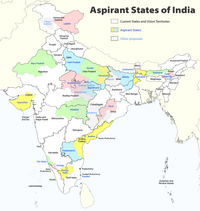 |
|---|---|---|
| East India | ||
| North India |
| |
| Northeast India |
| |
| South India |
| |
| West India |
| |
| Current states and union territories of India | ||
